Have you accidentally deleted precious memories from your digital camera? Don’t panic! How To Retrieve Deleted Photos From Digital Camera is possible, and dfphoto.net is here to guide you through the process of digital image recovery, ensuring you can salvage those cherished moments. We will explore proven methods and techniques, offering a reliable solution to restore your lost digital artwork.
1. Understanding Digital Camera Photo Loss
Digital cameras have revolutionized photography, making it easier than ever to capture and store high-quality images. However, the convenience of digital photography comes with its own set of challenges, one of the most frustrating being the accidental loss of photos. It’s crucial to understand the common reasons why photos disappear from your digital camera to prevent future occurrences.
1.1 Common Causes Of Photo Loss
- Accidental Deletion: This is the most frequent reason. In a hurry or by mistake, you might select and delete images you intended to keep.
- Card Formatting: Intentionally or unintentionally formatting the memory card erases all data stored on it.
- Memory Card Corruption: This can occur due to various factors, including physical damage, improper handling, or software issues.
- Power Interruption: Turning off the camera or removing the memory card during a write process can corrupt the files.
- Virus/Malware Infection: Connecting your memory card to an infected device can lead to data loss or corruption.
1.2 The Lingering Question: Are Deleted Photos Really Gone?
When you delete a photo from your digital camera, it isn’t immediately wiped from the memory card. Instead, the space it occupied is marked as available for new data. The original photo remains intact until it’s overwritten by new information. This offers a window of opportunity for photo recovery, provided you act quickly.
2. Immediate Actions to Take After Photo Loss
Once you realize that photos have been deleted, it’s crucial to take immediate steps to increase the chances of successful recovery. Every moment counts, as continued use of the camera could lead to overwriting the deleted files.
2.1 Stop Using the Camera
The most important thing to do is to immediately stop using the camera. Taking more photos or videos will increase the likelihood of overwriting the deleted files, making them unrecoverable.
2.2 Remove the Memory Card
Carefully remove the memory card from the camera and store it in a safe place. This will prevent any accidental use of the camera that could overwrite the deleted photos.
2.3 Avoid Writing New Data to the Card
Do not attempt to save any new files to the memory card, including photos, videos, or any other type of data. Writing new data will decrease the chances of successful photo recovery.
3. Initial Recovery Attempts: Checking Camera & Computer
Before resorting to specialized recovery software, there are a few simple steps you can take to see if the photos can be recovered directly from your camera or computer.
3.1 Check the Camera’s Recycle Bin/Trash Folder
Some digital cameras have a recycle bin or trash folder where deleted photos are temporarily stored. Check your camera’s manual for instructions on how to access and restore files from this folder.
3.2 Look for Hidden Files on Your Computer
Connect the memory card to your computer and check for hidden files. On Windows, you can do this by:
- Opening File Explorer.
- Clicking on the “View” tab.
- Checking the “Hidden items” box.
On macOS, you can use the following keyboard shortcut:
Cmd + Shift + . (period)
This will reveal any hidden files or folders on the memory card.
3.3 Utilizing the “Undelete” Function (If Available)
Some operating systems or file management tools offer an “undelete” function that can recover recently deleted files. Check your operating system’s documentation for instructions on how to use this feature.
4. Professional Photo Recovery Software: Your Best Bet
If the initial recovery attempts are unsuccessful, your best bet is to use professional photo recovery software. These tools are specifically designed to scan memory cards and hard drives for deleted files and recover them.
4.1 Introducing Reliable Recovery Software Options
Here are some of the most reliable and user-friendly photo recovery software options available:
- MiniTool Photo Recovery: A powerful and easy-to-use tool that supports various file formats and storage devices.
- Recuva: A free and effective recovery tool that can recover deleted photos, videos, and other files.
- EaseUS Data Recovery Wizard: A comprehensive data recovery solution that can recover files from various storage devices.
- Stellar Photo Recovery: A specialized photo recovery tool that supports a wide range of camera models and file formats.
4.2 Step-by-Step Guide to Using MiniTool Photo Recovery
MiniTool Photo Recovery is an excellent choice for retrieving deleted photos from your digital camera. Here’s a step-by-step guide on how to use it:
-
Download and Install: Download MiniTool Photo Recovery from the official website and install it on your computer.
MiniTool Windows Photo RecoveryClick to Download100%Clean & Safe -
Connect the Memory Card: Connect your digital camera to your computer, or remove the SD card and connect it using a card reader.
-
Launch the Software: Launch MiniTool Photo Recovery to get its main interface. Click the Start button to initiate digital camera photo recovery.
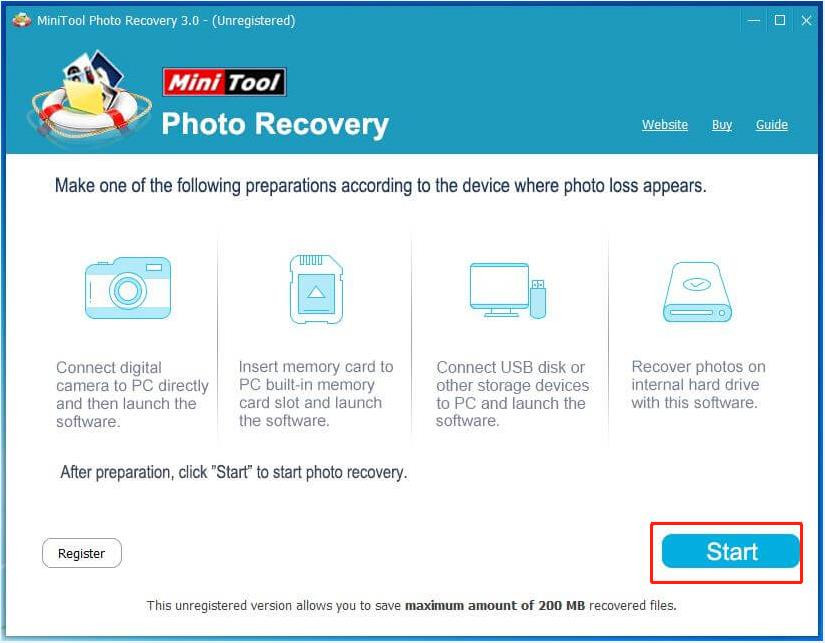 click Start
click Start -
Select the Drive: In the new pop-up window, you can use the Setting feature to make MiniTool Photo Recovery scan needed files only. For example, since you just want to recover pictures or photos, you can check the option of “Graphics & Picture” only. Also, you can only choose needed image formats like JPG, PNG, and so on.
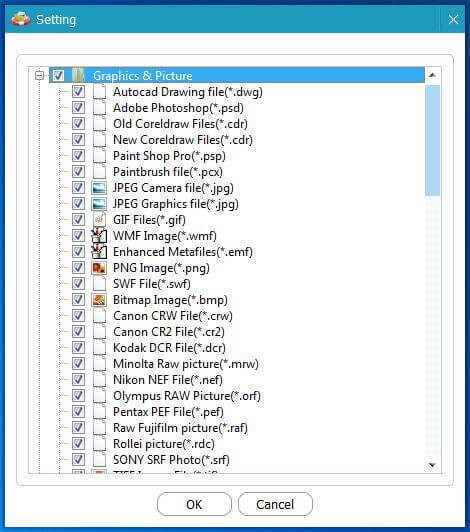 specify needed file types
specify needed file types -
Scan the Memory Card: Select the memory card that should contain your lost photos and then click the Scan button located at the lower right corner to start scanning for data.
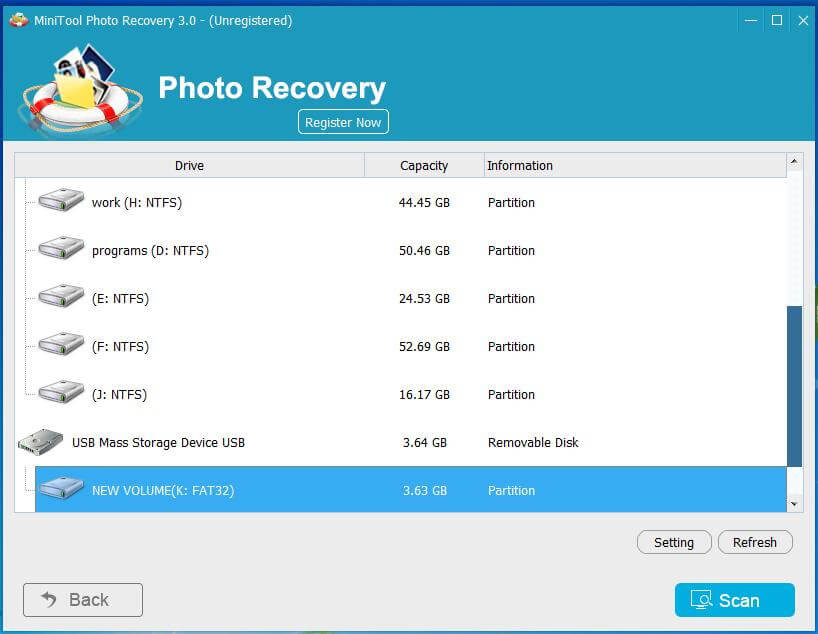 scan the target drive
scan the target drive -
Preview and Recover: After scanning, all found files are listed in the scan result window. At this time, you can preview found photos and select all photos you want. After that, click the Save button, then click Browse to choose an appropriate location to store them.
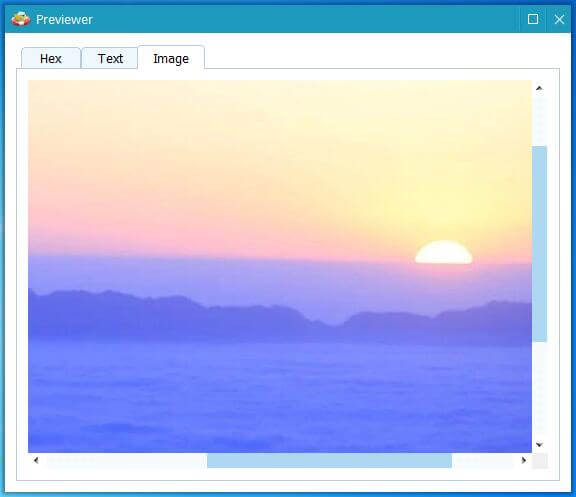 preview found photos
preview found photos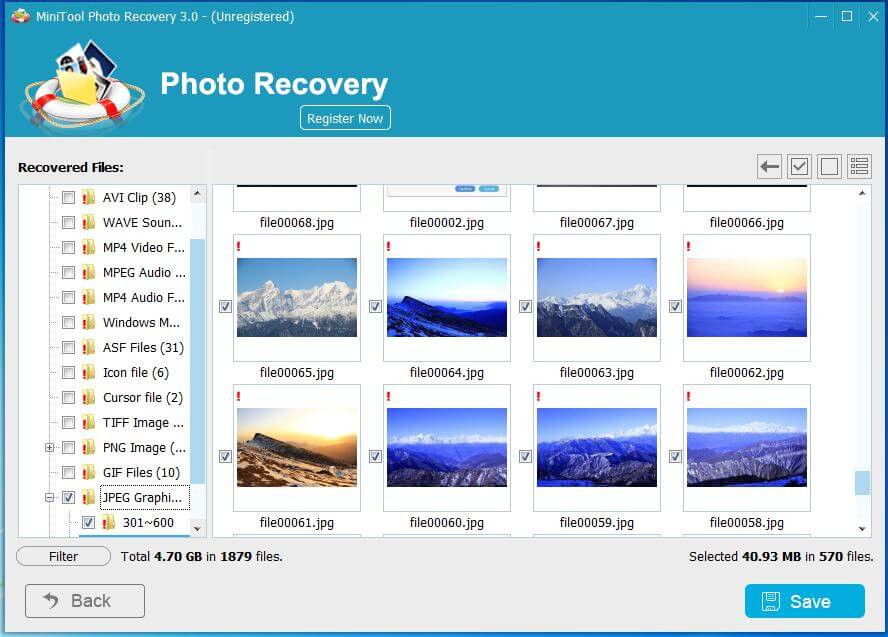 save all needed photos
save all needed photos
4.3 Tips for Maximizing Recovery Success
- Act Quickly: The sooner you start the recovery process, the higher the chances of success.
- Scan Thoroughly: Choose the deep scan option if available to ensure a more comprehensive search for deleted files.
- Save to a Different Drive: Always save the recovered photos to a different drive or storage device to avoid overwriting the original files.
- Preview Before Recovering: Use the preview function to verify the integrity of the recovered photos before saving them.
5. Alternative Solutions: Data Recovery Services
In some cases, photo recovery software may not be able to recover the deleted photos, especially if the memory card is severely damaged or the files have been overwritten. In such situations, you may need to consider using a professional data recovery service.
5.1 When to Consider a Professional Service
- Physically Damaged Card: If the memory card is physically damaged, such as broken or water-damaged, a professional service is necessary.
- Overwritten Files: If the deleted photos have been overwritten by new data, recovery software may not be effective.
- Complex Data Loss Scenarios: If the data loss is due to a complex issue, such as a virus infection or file system corruption, a professional service may be required.
5.2 How Data Recovery Services Work
Data recovery services have specialized equipment and expertise to recover data from damaged storage devices. They typically involve the following steps:
- Evaluation: The service will evaluate the memory card to determine the extent of the damage and the feasibility of recovery.
- Recovery: The service will use specialized tools and techniques to attempt to recover the deleted photos.
- Delivery: If the recovery is successful, the service will provide you with the recovered photos on a new storage device.
5.3 Choosing a Reputable Recovery Service
When choosing a data recovery service, consider the following factors:
- Experience: Look for a service with a proven track record of successful data recovery.
- Expertise: Ensure the service has the necessary expertise and equipment to handle your specific data loss scenario.
- Security: Choose a service that takes data security seriously and has measures in place to protect your privacy.
- Cost: Get a clear estimate of the recovery costs before proceeding.
6. Protecting Your Memories: Prevention Tips
While it’s reassuring to know that you can often recover deleted photos, the best approach is to prevent data loss in the first place. Here are some preventative measures you can take:
6.1 Regular Backups: Your Safety Net
Regularly back up your photos to a separate hard drive, cloud storage service, or other storage device. This will ensure that you always have a copy of your photos in case of accidental deletion, memory card corruption, or other data loss scenarios.
6.2 Safe Memory Card Handling Practices
- Eject Properly: Always use the “safely remove hardware” option when ejecting a memory card from your computer.
- Avoid Extreme Temperatures: Do not expose your memory card to extreme temperatures or humidity.
- Handle with Care: Handle your memory card with care to avoid physical damage.
- Use Quality Cards: Invest in high-quality memory cards from reputable brands to minimize the risk of corruption.
6.3 Camera Settings & Workflow Optimization
- Write-Protect Switch: Utilize the write-protect switch on your memory card to prevent accidental deletion.
- Review Photos Regularly: Review your photos regularly and delete any unwanted images to free up space on your memory card.
- Format Cards in Camera: Format your memory card in the camera before each use to ensure optimal performance.
7. Understanding Memory Card Types and Their Impact on Recovery
Different types of memory cards are used in digital cameras, each with its own characteristics and potential impact on data recovery.
7.1 SD Cards: The Industry Standard
SD (Secure Digital) cards are the most common type of memory card used in digital cameras. They come in various sizes and speed classes, each suited for different types of photography.
- SD: Original SD cards with capacities up to 2GB.
- SDHC: High Capacity SD cards with capacities from 2GB to 32GB.
- SDXC: Extended Capacity SD cards with capacities from 32GB to 2TB.
- SDUC: Ultra Capacity SD cards with capacities up to 128TB.
7.2 CF Cards: High Performance Option
CF (CompactFlash) cards are another popular type of memory card, particularly among professional photographers. They offer high storage capacities and fast data transfer speeds.
7.3 Memory Stick: Sony’s Proprietary Format
Memory Stick is a proprietary memory card format developed by Sony. It’s commonly used in Sony digital cameras and camcorders.
7.4 Card Speed and Its Relevance
The speed of a memory card is measured in terms of its read and write speeds. Faster cards allow you to capture photos and videos more quickly and efficiently.
- Speed Class: Indicates the minimum sustained write speed of the card.
- UHS Speed Class: Indicates the minimum write speed for UHS (Ultra High Speed) cards.
- Video Speed Class: Indicates the minimum write speed for recording videos.
8. The Role of File Systems in Photo Recovery
The file system used on a memory card plays a crucial role in data storage and retrieval. Understanding the different file systems can help you better understand how photo recovery works.
8.1 FAT32: The Traditional Format
FAT32 (File Allocation Table 32) is a traditional file system commonly used on SD cards. It has a maximum file size limit of 4GB.
8.2 exFAT: Overcoming Size Limitations
exFAT (Extended File Allocation Table) is a modern file system designed to overcome the limitations of FAT32. It supports larger file sizes and is commonly used on SDXC cards.
8.3 File System Corruption and Its Impact
File system corruption can occur due to various factors, including improper handling, power interruptions, or software issues. This can lead to data loss or make it difficult to recover deleted photos.
9. Advanced Recovery Techniques: Hex Editors & Raw Recovery
For advanced users, hex editors and raw recovery techniques can be used to recover deleted photos from digital cameras.
9.1 Using Hex Editors for File Carving
Hex editors allow you to view and edit the raw data on a storage device. This can be useful for identifying and recovering deleted photos that are not recognized by recovery software.
9.2 Raw Recovery: Bypassing the File System
Raw recovery involves scanning the memory card for specific file signatures, such as JPEG headers, and extracting the corresponding data. This technique can be effective for recovering photos from corrupted file systems.
9.3 When to Employ These Methods
These advanced techniques should only be used by experienced users who are comfortable working with raw data. They can be time-consuming and require a deep understanding of file systems and data structures.
10. Legal and Ethical Considerations in Photo Recovery
When recovering deleted photos from digital cameras, it’s important to be aware of the legal and ethical considerations involved.
10.1 Respecting Privacy and Ownership
If you’re recovering photos from a memory card that doesn’t belong to you, it’s important to respect the privacy and ownership of the data. Do not attempt to recover or view photos without the owner’s permission.
10.2 Data Protection Laws and Regulations
Be aware of any data protection laws or regulations that may apply to the recovery of personal data.
10.3 Seeking Permission When Necessary
If you’re unsure about the legal or ethical implications of recovering deleted photos, seek legal advice or consult with a data recovery professional.
FAQ: Retrieving Deleted Photos From Digital Camera
Q1: Can I recover deleted photos from my digital camera’s internal memory?
A1: Yes, but it’s more complex. You’ll likely need specialized software or a data recovery service. Most cameras don’t allow direct access to internal memory for data recovery purposes.
Q2: Will formatting my memory card permanently erase my photos?
A2: Not necessarily. Formatting makes the space available for new data, but the original photos may still be recoverable using recovery software. Stop using the card immediately to prevent overwriting.
Q3: Does the brand of my digital camera affect photo recovery?
A3: The brand itself doesn’t directly affect recovery. However, different cameras use different file systems and storage methods, so compatibility with recovery software may vary.
Q4: Is it possible to recover videos as well as photos?
A4: Yes, most photo recovery software can also recover videos. The process is similar to recovering photos.
Q5: How long does it take to recover deleted photos?
A5: It depends on the size of the memory card, the amount of data, and the speed of your computer. It can take anywhere from a few minutes to several hours.
Q6: Can I recover photos from a water-damaged memory card?
A6: It’s possible, but the chances of success are lower. You’ll need to dry the card thoroughly and try using recovery software or a data recovery service.
Q7: Is free photo recovery software as good as paid software?
A7: Free software can be effective for simple data loss scenarios. Paid software often offers more advanced features and better recovery rates.
Q8: What is the best way to back up my photos?
A8: Use a combination of methods, such as an external hard drive, cloud storage, and a second memory card. Regularly back up your photos to ensure you have multiple copies.
Q9: What if the recovered photos are corrupted?
A9: Try using a different recovery software or a data recovery service. The original files may be partially overwritten, making them difficult to recover completely.
Q10: How can I prevent photo loss in the future?
A10: Regularly back up your photos, handle memory cards with care, use a high-quality memory card, and avoid deleting photos accidentally.
Conclusion: dfphoto.net is Here to Help!
Losing photos from your digital camera can be a distressing experience. However, with the right knowledge and tools, you can often recover those cherished memories. Remember to act quickly, choose the right recovery method, and take preventative measures to protect your photos in the future.
Visit dfphoto.net for more comprehensive guides, software reviews, and expert advice on all things photography! Whether you’re grappling with technical challenges or seeking creative inspiration, dfphoto.net is your ultimate resource.
Ready to dive deeper into the world of photography? Explore our extensive collection of tutorials, stunning photo galleries, and a vibrant community of photographers waiting to connect with you. Don’t just capture moments; preserve them for a lifetime. Visit dfphoto.net today and unlock your full photographic potential.
Address: 1600 St Michael’s Dr, Santa Fe, NM 87505, United States
Phone: +1 (505) 471-6001
Website: dfphoto.net

